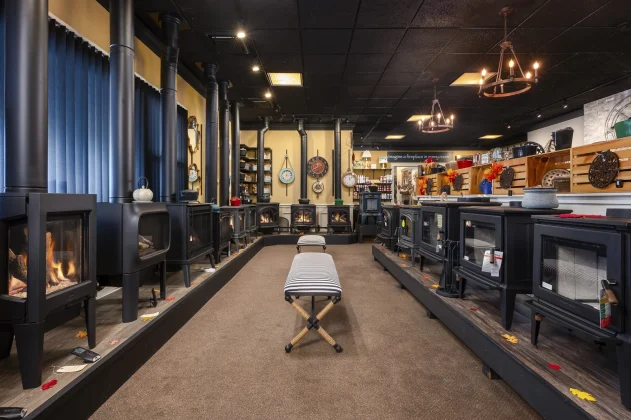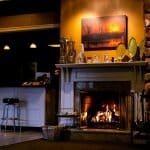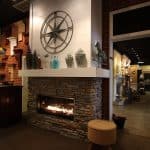A wood-burning fireplace is a wonderful addition to every home. It brings warmth, ambiance, and style to any space. For effective usage, it is important to maintain your fireplace and keep it in the best condition. A well-maintained fireplace will not only save your time and money but also add tremendous value to your home and amaze your family members.
In this article, we shall discuss top ten tips for maintaining a wood-burning fireplace.
1. Clean the interior
Burning of woods in our fireplaces often cause deposit and buildup of a variety of dirt, dust, ash, and creosote. Therefore, make sure you clean the interior part of the fireplace regularly. This will not only make it look more presentable but also make the fireplace burn more efficiently.
Moreover, the buildup of creosote and other materials are potentially dangerous to the home. Many of these fine particles can be transmitted through the air and can cause a number of air-borne diseases if inhaled for a considerable long period of time. More so, cleaning the fireplace will prevent it from catching fire unnecessarily. We recommend that you use a dust mask to prevent inhalation of these dust particles during cleaning.
2. Install Heat Proof Glass Doors and Blower or Fan
Of course, the safety of you and your family is of utmost importance. Installing heat-proof glass and a fan can add another layer of protection. Heat Proof Glass can help with containing any burning material like embers and dust particles. A fan or blower can help to increase the efficiency of the heat in your home by circulating the heat over a larger area.
Fireplace glass doors have been proven to decrease the potential for injury to those you care about and also reduce the risk of damage to your home. When most people think about the dangers of a fireplace they often think about the worst case scenario which would be a raging house fire due to poor chimney maintenance, creosote build-up, or a poor chimney draft. But too often the less obvious threats of heating your home with fireplace are ignored and are the ones that could sneak up on you and cause devastating results.
Glass fireplace doors greatly reduce the chances of sparks or logs tumbling out of the fireplace which can damage tile or wood flooring, destroy carpeting, melt linoleum or even worse roll right into someone standing next to the fireplace. Without fireplace glass doors, sparks and cinders are free to float and pop from the fireplace and land on clothing, furniture or other home furnishings which can cause considerable damage to property that surrounds the fireplace.
Fireplace glass doors are able to greatly increase the efficiency of the fireplace by acting as a barrier between your home and your chimney. An open fireplace is just like an open window. When left open in the winter, the fireplace will allow warm air to escape up and out the chimney and in the summer cool air conditioned air is able to escape from the chimney. In both cases, fireplace glass doors increase efficiency by minimizing the amount of air lost up the chimney which saves you money
However, the Heat Proof Glass Doors should be cleaned regularly to prevent the buildup of materials and keep your fireplace in a good condition. You can use a light sandpaper to scrape off any tougher buildups.
3. Watch for Smoke
An efficiently-burning fireplace should not send smoke into the home. Hence, if you notice any smoke from the fireplace, it could be a warning signal and you should immediately consider cleaning your fireplace.
There are many reasons why your fireplace can give off smoke. The major reason is either a wrong wood-burning practice or a dirty chimney with a buildup of soot or creosote. It can also be because there is debris in the chimney blocking the venting of the smoke. Likewise, you should check the damper and ensure that it is fully and widely open. It is very important to pay a critical attention to your fireplace whenever you notice smoke.
4. Burn the Right Wood
Wood burning is an art as well as a science. Thus, you should know that kind of wood you are burning in your fireplace and utilize the best wood-burning practices. It is wise to know the kind of wood you are burning. There are different kinds of woods – expensive and cheap – but the cost does not necessarily determine the quality. Hardwood remains that best kind of wood to burn in fireplaces.
Tress like oak, birch, and ash have an advantage in that they burn hotter and longer. More so, they have less sap and pitch which makes them easier to handle while they likewise cause less creosote buildup. Softwood can be a cheaper alternative but is not always efficient when it comes to burning. Some do not produce enough heat and produce smoke and creosote in a large quantity.
5. Look for Soot
Soot is also another potentially harmful by-product of burning wood and can cause a number of issues if not properly managed. Unlike creosote, soot is softer and can easily spread across a wider area and difficult to clean as a result. Soot can cause a fire outbreak if present in a large volume. We recommend that you regularly clean soot deposits especially when it gets larger than 1/8 inch deep.
6. Remove Creosote
Creosote is a dark, hard, crust-like flammable substance that appears after an incomplete combustion of wood. Poorly dried and stored woods generally produce a large amount of creosote than woods that have been properly dried and stored. An excessive buildup of creosote can cause the chimney to catch fire.
What’s more, a hotter fire will produce fewer creosotes and high airflow will help with maintaining a proper burn. If you notice any buildup, make sure you immediately use a chimney brush to evacuate the building. Also, make sure you properly and regularly inspect the stove pipe.
7. Check the Cap
Your chimney may likely have a cap on the top of side to keep unwanted materials and small animals away. Dust and dirt usually build up around this cover and can reduce the efficiency of your fireplace. Therefore, clean this cap often by removing the debris. This will enhance proper airflow and allow the smoke to escape successfully.
If there is a barricade at this cap, you are running a risk of having creosote buildup inside the chimney and thus, a risk of fire outbreak. In this case, we often recommend that you hire the service of a professional chimney sweep to help you with the cleaning and maintenance.
8. Inspect Your Chimney
Whether you are using a metal or masonry chimney, there are some factors to consider. If you are using a masonry chimney, you should examine the outer mortal lying between the bricks or stone to make sure it is intact. Any cracks could be a sign of a possible larger problem or the beginning of one. More so, you should consider replacing any crumbling mortar, missing bricks and cracked tile liners.
A metal chimney, on the other hand, should be regularly inspected for dents, dust, and rusts. Check for any missing dent or screw and rusts at the joints as these are early signs of weakness.
9. Annual Inspection and Maintenance
Apart from the regular DIY cleaning and maintenance, you need to hire a professional installer to inspect your fireplace every year, especially close to the winter. This will ensure that your fireplace is in good condition and prepare it for the season. It is possible for you to skip many things while performing your regular cleaning. More so, there are many things you may not observe during your cleaning routine. A specialist will professional inspect your fireplace and make appropriate recommendations.
Bottom line
Proper maintenance of your fireplace is a great step towards keeping it efficient for years to come. More so, it also helps to keep your home from any potential hazards that may arise from dirty and unmanaged fireplaces. It is always better to avoid fireplace-related accidents than to start finding solutions to them.






